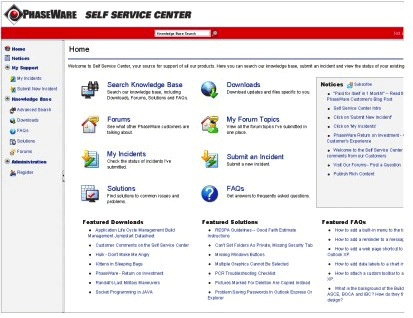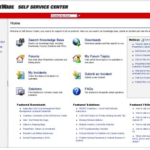Organizations use customer service and support software to track and manage service interactions, whether by phone, over the Web, through email, by social media or even face-to-face. However, there are hundreds of solutions on the market and selecting the best customer service software for your organization is challenging. To support you, here’s what we’ll cover in this guide:
What Is Customer Service Software?
Common Features of Customer Service Software
What Type of Buyer Are You?
Customer Service Software BuyerView Report
Benefits of Customer Service Software
What Is Customer Service & Support Software?
Customer service and support software helps customer service representatives (CSRs, or “agents”) document, route, track, resolve and report on customer issues using a trouble ticketing system. This technology is sometimes referred to as help desk software, though that term is usually applied to resolving information technology (IT) issues.
These solutions streamline the issue resolution process by automating many common support activities. Ultimately, they improve agent productivity and increase customer satisfaction.
Some customer service support systems may be integrated with other enterprise applications. Examples include service dispatch software (to enable on-site repairs), inventory and cataloging systems (to ensure that exchange parts are in stock) and sales force automation systems (to inform sales reps of critical or chronic issues).
Common Features of Customer Service Software
Depending on the type of buyer you are, below is a list of common and useful features that are found in customer service and support solutions and online customer support software. This is not an exhaustive list but is a good place to start.
| Live chat | Allows CSRs to chat with customers online and automatically capture key content from those conversations in the trouble ticketing system. Many customers prefer to interact with CSRs by chat instead of by phone. |
| Customer self service | Offers a Web-based customer portal through which customers can search for answers to common problems. This can take the form of documentation, searchable FAQs and how-to pages, among other things. If the customer can’t find an answer, Web self-service tools usually enable them to submit a ticket online or engage in live chat with a CSR. |
| Knowledge base | Manages a repository of descriptions to common or previously resolved problems. These resources might be available publicly via a self-service website, or reserved for internal use by CSRs. |
| Multi-channel management | Manages customer interactions received through multiple channels, including phone, Web, email, live chat, mobile app, Facebook, Twitter and others. All interactions are stored in the software and routed to appropriate agents for resolution. |
| Analytics and reporting | Enables managers to create custom reports that provide insight on team performance, time to resolution, customer satisfaction and other important indicators. |

What Type of Buyer Are You?
When beginning your customer service support software comparison, keep in mind that different organizations have different drivers and requirements. They typically break out as follows:
| Enterprise buyer | These buyers work for organizations that typically have a lot of users, have complex functional requirements and value the vision of an integrated software system across all departments and business units. They will typically employ a best of breed strategy. Representative vendors include Salesforce, Oracle RightNow CX and SAP. |
| High-volume call center buyer | These buyers operate one or more large call centers. Their goal is often to manage as much of the call center business process as possible using automated rules and scripts, which many customer service software applications support. These buyers should also look for computer telephony integration (CTI). Representative vendors include inContact, SAP, Salesforce.com and Goldmine CRM. |
| Small business CRM buyer | These small businesses want to evolve beyond contact tracking capabilities of products like Microsoft Outlook and add basic trouble ticketing and interaction tracking to enhance relationships with strong service and support. Representative vendors include inContact, GoldMine CRM, Zendesk, Maximizer CRM and SageCRM. |
| Field service buyer | These buyers work for large firms that deliver service at the customer location and will benefit from mobile access. These buyers will also look for strong client data integration with other applications. Representative vendors include PhaseWare Tracker, FieldAware, SugarCRM and Microsoft Dynamics CRM. |
Customer Service BuyerView | 2014
We’ve spoken with hundreds of customer service software buyers over the years. Based on these interactions, we compiled answers to the following questions:
-
- What systems to buyers currently use?
-
- For those replacing an existing system, what are their top reasons for doing so?
-
- For those buying customer service software for the first time, what are their top reasons for doing so?
-
- Which features do buyers request most?
-
- Which deployment model did buyers evaluate most?
From this research, we discovered that many times companies buy customer service software when they need to scale. They might have been using a more a general contact management software system before, but grew to the point of needing more specialized customer service features, such as trouble ticketing. Others in the sample were buying because they needed to increase efficiency, resolve issues faster, or consolidate their databases. Click here for the full report.
Benefits of Customer Service Software
A well-implemented customer service solution increases satisfaction, empowers agents and provides transparency and reporting to management on the support process. Some of the benefits customer service systems can deliver include:
Increased accountability. By documenting every contact, a system allows management to see which agent handled which problem and provides agents with ongoing feedback on their performance.
Improved coordination of accounts. When paired with sales force automation systems, customer support systems afford both the sales and the service organizations better transparency into the customer’s data. This can yield benefits such as letting sales representatives know of any outstanding issues before making a call, or letting an agent know that repair parts are already ordered so that a customer does not double order parts.
Better asset management. Customer care software systems that fully integrate with service dispatch allow reps to be more efficiently assigned. Similarly, integration with the inventory management system will allow agents to confidently confirm that repair parts are in stock to the customer.
Improved infrastructure scalability. Customer self-help systems handle straightforward issues, giving customers with more complex problems faster access to agents. This allows a growing company to expand at a faster rate while maintaining or improving customer satisfaction.
Reduce time required to resolve issues. Customer service management software reduces the amount of time required to resolve an issue. This means that the same number of agents can address more issues, or the same load can be handled by fewer agents. For example, YouSendIt was able to respond to customers 35 percent faster after implementing Zendesk customer support software.





